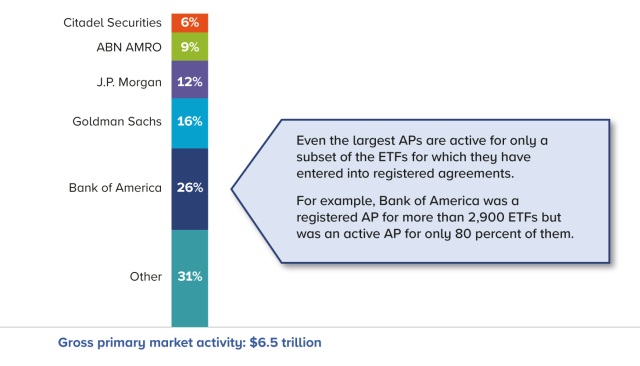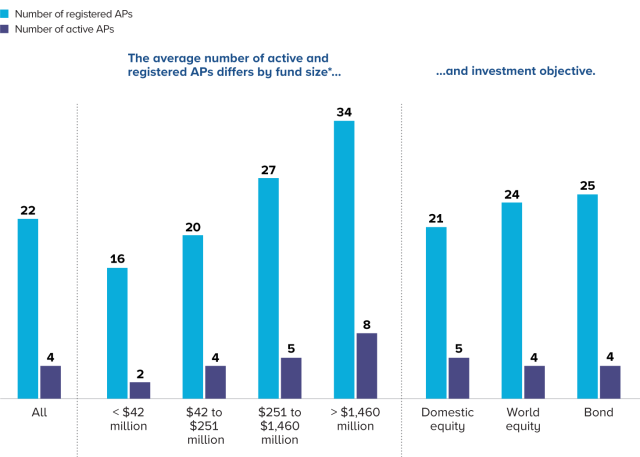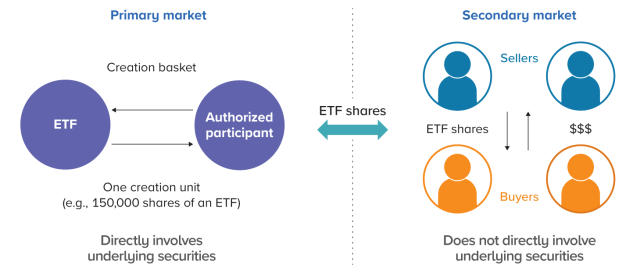
Frequently Asked Questions About ETF Basics and Structure
What is an ETF?
What is an AP?
What kind of investments can investors make through ETFs?
What is the history of ETFs?
How do ETFs work toward their investment objective?
How are ETFs created?
How are ETFs redeemed?
How can an investor be sure that an ETF’s price reflects its asset value?
What is included in ICI’s monthly ETF report?
What is an ETF?
An exchange-traded fund (ETF) is a pooled investment vehicle with shares that trade intraday on stock exchanges at a market-determined price. Investors may buy or sell ETF shares through a broker or in a brokerage account, just as they would the shares of any publicly traded company. Unlike traditional mutual fund shares, ETF shares are created when an “authorized participant” or AP, typically a large financial institution, provides a specified basket of securities, cash, or both—often called a “creation basket”—to the ETF. In return, the AP receives a fixed amount of ETF shares, called a “creation unit.” Some or all of these shares may then be sold on a stock exchange. An AP may redeem ETF shares in creation unit increments in exchange for a “redemption basket” of securities, cash, or both.
Retail investors can only buy and sell the ETF shares on an exchange, much as they can buy or sell any listed equity security. Unlike an AP, a retail investor cannot purchase or redeem shares directly from the ETF as they would from a traditional mutual fund.
What is an AP?
An authorized participant (AP) is typically a large financial institution that enters into a legal contract with an ETF distributor to create and redeem shares of the fund. In addition, APs are US-registered, self-clearing broker-dealers that can process all required trade submission, clearance, and settlement transactions on their own account; they are also full participating members of the National Securities Clearing Corporation (NSCC) and the Depository Trust Company (DTC).
APs play a key role in the primary market for ETF shares because they are the only investors allowed to interact directly with the fund. APs do not receive compensation from an ETF or its sponsor and have no legal obligation to create or redeem the ETF’s shares. Rather, APs typically derive their compensation from acting as dealers in ETF shares. Also, APs create and redeem shares in the primary market when doing so is a more effective way of managing their firms’ aggregate exposure than trading in the secondary market. Some APs are clearing brokers (rather than dealers) and receive payment for processing creations and redemptions as an agent for a wide array of market participants such as registered investment advisers and various liquidity providers, including market makers, hedge funds, and proprietary trading firms.
There were 62 APs that had registered agreements with ETF sponsors in 2023, of which 37 of them were active (i.e., they created and redeemed shares). This difference reflects the fact that not all APs are active in any given year. For example, some APs enter into agreements with ETF sponsors so they have the option to engage in primary market activity should (and when) they want to do so. Over the years, policymakers have expressed concerns that APs will step away from their role in facilitating creations and redemptions of ETF shares during periods of market stress. However, data on APs and primary market activity during the COVID-19 crisis show that rather than pulling back, APs stepped in—with more APs facilitating significantly higher volume of ETF creations and redemptions compared with a normal period in the year prior.
Bank of America, Goldman Sachs, and JP Morgan facilitated the most creations and redemptions for ETFs in 2023, collectively accounting for more than half of all ETF creations and redemptions. Despite their collective activity, these APs do not engage in primary market activity for all the ETFs for which they have contractual agreements. For example, Bank of America had agreements with more than 2,900 ETFs in 2023 but was an active AP for only 80 percent of them.
Three APs Created and Redeemed The Majority of ETF Shares in 2023
Percentage of total dollar value of gross creation and redemption activity for ETFs, annual, 2023

Note: Data include ETFs that filed a Form N-CEN in 2023 and had not liquidated or merged at any point during the year.
Source: ICI calculations of publicly available Form N-CEN data
On average, most ETFs have multiple APs that engage in creations and redemptions of their shares. In 2023, each ETF had an average 22 registered APs that could create and redeem shares of the fund and four APs that were actively doing so. In general, larger ETFs with relatively higher trading volume tend to have both more active APs and a greater number of AP agreements in place. The number of registered versus active APs also varies somewhat by investment objective.
On Average, Each ETF Has Four Active APs Engaging in Primary Market Activity During the Year*
The average number of registered APs able to facilitate primary market activity for each ETF is far larger

*Data represent quartiles based on ETF total net assets at year-end 2023.
Note: Data include ETFs that filed a Form N-CEN in 2023 and had not liquidated or merged at any point during the year.
Sources: Investment Company Institute and publicly available Form N-CEN data
What kind of investments can investors make through ETFs?
As with mutual funds, investors in ETFs can access a wide variety of investment strategies and markets, both domestic and international. Among other things, ETFs invest in broad and narrow market indexes covering particular market sectors and industries. ETFs also invest in commodities.
Index-based ETFs are designed to track the performance of specified market indexes. In some cases, an ETF may track a multiple of its index, an inverse of its index, or even a multiple inverse of its index. Actively managed ETFs do not seek to track the return of a particular index. Instead, an actively managed ETF’s investment adviser, like that of an actively managed mutual fund, creates a unique mix of investments to meet a particular investment objective and policy.
What is the history of ETFs?
The first US ETF—a broad-based domestic equity fund tracking the S&P 500 index—was launched in 1993 after a fund sponsor received Securities and Exchange Commission (SEC) exemptive relief from several provisions of the Investment Company Act of 1940 that would not otherwise allow the ETF structure. As other fund sponsors wanted to bring new ETFs to market, they had to obtain their own specific exemptive relief orders from the SEC. Until 2008, the SEC only approved exemptive relief orders for ETFs that tracked specified indexes. These ETFs, commonly referred to as index-based ETFs, are designed to track the performance of their designated indexes or, in some cases, a multiple or an inverse (or a multiple of an inverse) of their indexes. At year-end 2023, there were 1,872 index-based ETFs—with $7.4 trillion in total net assets—that were registered with the SEC under the Investment Company Act of 1940.
In early 2008, the SEC granted approval through exemptive relief orders to several fund sponsors to offer fully transparent, actively managed ETFs. Actively managed ETFs do not seek to track the return of a particular index. Instead, an actively managed ETF’s investment adviser, like that of an actively managed mutual fund, creates a unique mix of investments to meet a particular investment objective and strategy. As other fund sponsors wanted to offer actively managed ETFs, they had to obtain their own exemptive relief. From the approval of the first actively managed ETFs in 2008 through year-end 2023, the market has grown to 1,178 actively managed 1940 Act ETFs with $515 billion in total net assets.
After granting more than 300 exemptive orders to fund sponsors for index-based and fully transparent actively managed ETFs since 1993, the SEC adopted the “ETF rule” (Rule 6c-11 under the Investment Company Act of 1940) in September 2019. The ETF rule enables any fund sponsor to offer ETFs that satisfy certain conditions (e.g., daily disclosure of all portfolio holdings, net asset value [NAV], market price, premium or discount, and bid-ask spread; as well as written policies and procedures regarding basket construction) without the expense and delay of obtaining exemptive relief from the SEC. The ETF rule also removes a competitive disadvantage that favored some ETF sponsors with older, more flexible forms of exemptive relief. Under the new rule, the vast majority of ETFs currently registered with the SEC are subject to identical requirements.
In 2019, the SEC also granted separate approval through the exemptive relief process to five models of ETFs that did not fall under the new ETF rule because they do not fully disclose their portfolio holdings each day. These ETFs, commonly referred to as non-transparent or semitransparent ETFs, provide limited daily information on the value of the securities they hold and, similar to mutual funds, publicly disclose their full schedule of portfolio holdings at least quarterly. These new ETFs have been approved for use only in limited asset classes—primarily domestic equity—and must prominently disclose on their prospectuses, websites, and marketing materials that they are different from the more traditional ETFs allowed under the ETF rule. The first ETFs of this new type were launched in 2020, and by year-end 2023 there were 54 of these funds with $5.2 billion in total net assets.
How do ETFs work toward their investment objective?
An ETF originates with a sponsor—a company or financial institution—that chooses the investment objective of the ETF. In the case of an index-based ETF, the sponsor chooses both an index and a method of tracking its target index. Many early ETFs tracked traditional indexes, mostly those weighted by market capitalization. As the industry has evolved, index-based ETFs have tended to follow benchmarks that use an array of index construction methodologies, with weightings based on market capitalization, as well as other fundamental factors, such as sales or book value. Others follow factor-based metrics—indexes that first screen potential securities for a variety of attributes, including dividend payments, value, or growth—and then weight the selected securities equally or by market capitalization. Other customized index approaches include screening, selecting, and weighting securities to minimize volatility, maximize diversification, or achieve a high or low degree of correlation with the market.
Index-based ETFs track their target index in various ways. An index-based ETF may replicate its index (that is, it may invest 100 percent of its assets proportionately in all the securities in the target index) or it may invest in a representative sample of securities in the target index. Representative sampling is a practical solution for ETFs tracking indexes that contain thousands of securities (e.g., total stock market or broad-based fixed-income indexes), securities that have restrictions on ownership or transferability (e.g., certain foreign securities), or securities that are difficult to obtain (e.g., some fixed-income securities).
The sponsor of an actively managed ETF determines the investment objective of the fund and may trade securities at its discretion, much like an actively managed mutual fund. For instance, the sponsor may try to achieve an investment objective such as outperforming a segment of the market or investing in a particular sector through a portfolio of stocks, bonds, or other assets.
How are ETFs created?
The creation or redemption of ETF shares—activity directly involving the ETF’s underlying securities—is categorized as primary market activity. The creation and redemption mechanism in the ETF structure allows the number of shares outstanding in an ETF to expand or contract based on demand. Each business day, ETFs publish the creation and redemption baskets for the next trading day. The creation and redemption baskets are specific lists of names and quantities of securities, cash, and/or other assets. Often baskets will track the ETF’s portfolio through either a pro rata slice or a representative sample. At times, baskets may be limited to a subset of the ETF’s portfolio and contain a cash component. For example, the composition of baskets for bond ETFs may vary from day to day with the mix of cash and the selection of bonds in the baskets based on liquidity in the underlying bond market. Typically, the composition of an ETF’s daily creation and redemption baskets mirror one another.
ETF shares are created when an AP submits an order for one or more creation units. A creation unit consists of a specified number of ETF shares, generally ranging from 25,000 to 250,000 shares. The ETF shares are delivered to the AP when the specified creation basket is transferred to the fund. The fund may permit or require an AP to substitute cash for some or all of the securities or assets in the creation basket. This generally occurs when an instrument in the creation basket is difficult to obtain or may not be held by certain types of investors (such as certain foreign securities). An AP also may be charged a cash adjustment or transaction fee to offset any transaction expenses the fund undertakes. The value of the creation basket and any cash adjustment equals the value of the creation unit based on the ETF’s NAV at the end of the day on which the transaction was initiated.
The AP can either keep the ETF shares that make up the creation unit or sell all or part of them to its clients or to other investors on a stock exchange, in a “dark pool” (private exchange), or in other trading venues. Purchases and sales of existing ETF shares among investors, including APs, are referred to as secondary market trading or activity.
Creation of ETF Shares

Note: The creation basket represents a specific list of securities, cash, and/or other assets.
How are ETFs redeemed?
The redemption process in the primary market is simply the reverse of the creation process. A creation unit is redeemed when an AP acquires the number of ETF shares specified in the ETF’s creation unit and returns the creation unit to the fund. In return, the AP receives the daily redemption basket of securities, cash, and/or other assets. The total value of the redemption basket and any cash adjustment is equivalent to the value of the creation unit based on the ETF’s NAV at the end of the day on which the transaction was initiated.
How can an investor be sure that an ETF’s price reflects its asset value?
The price of an ETF share on a stock exchange is influenced by the forces of supply and demand. Though imbalances in supply and demand can cause the price of an ETF share to deviate from its underlying value, substantial deviations tend to be short-lived for many ETFs. Two primary features of an ETF’s structure promote trading of its shares at a price that approximates its underlying value: portfolio transparency and the ability for APs to create or redeem ETF shares at the NAV at the end of each trading day.
Transparency of an ETF’s holdings—either through full disclosure of the portfolio or other information on the value of the securities—enables investors to observe and attempt to profit from discrepancies between the ETF’s share price and its underlying value during the trading day.
When there are discrepancies between an ETF’s market price and the value of its underlying securities, trading can more closely align the ETF’s price and its underlying value. For example, if an ETF is trading at a discount to its underlying value, investors may buy ETF shares or sell the underlying securities, or both. Increased demand for the ETF’s shares should raise its price, and any sales of the underlying securities should lower their prices, narrowing the gap between the ETF and its underlying value. If the ETF is trading at a premium to its underlying value, investors may choose to sell the ETF shares or buy the underlying securities, or both. These actions should bring the ETF’s price and the market value of its underlying securities closer together by reducing the ETF share price or raising the price of the underlying securities, or both.
The ability to create or redeem ETF shares at the end of each trading day also helps an ETF trade at market prices that approximate the underlying market value of the portfolio. When a deviation between an ETF’s market price and its underlying value occurs, APs (on their own behalf or on behalf of other market participants) may create or redeem creation units in the primary market in an effort to capture a profit. For example, when an ETF is trading at a discount, market participants may find it profitable to buy the ETF shares and sell short the underlying securities. At the end of the day, APs return ETF shares to the fund in exchange for the ETF’s redemption basket, which is used to cover the short positions in the underlying securities. When an ETF is trading at a premium, market participants may find it profitable to sell short the ETF during the day while simultaneously buying the underlying securities. At the end of the day, the APs (on their own behalf or on behalf of other market participants) will deliver the creation basket to the ETF in exchange for ETF shares that are used to cover the short sales.
These actions by market participants, commonly described as arbitrage, help keep the market-determined price of an ETF’s shares close to its underlying value.
What is included in ICI’s monthly ETF report?
The Institute’s monthly statistical collection includes the combined assets of the nation’s exchange-traded funds, and the value of shares issued and redeemed. All ETFs registered as investment companies with the SEC, as well as nonregistered ETFs, are included in the statistical release. Statistics contained in the report have been obtained from information provided to ICI by exchange-traded funds.
May 2024

